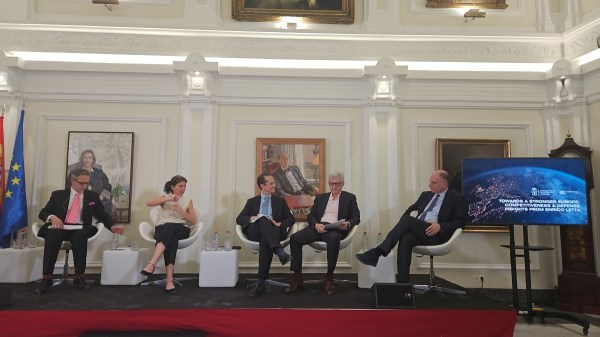On Friday 20 September, the panel “Sustainable digitally augmented spaces” took place in the framework of the OECD Global Forum on Technology at the OECD headquarters in Paris. The Forum brought together technology experts and decision-makers to reflect on the new technological developments and convergences that are certain to transform human experiences in high-impact areas such as health and education through sustainable, digitally augmented spaces.
Telefónica had the opportunity to reflect on the present and future, focusing on: (i) the impact of technology on our lives and the benefits of augmented reality, (ii) the usage gap and the importance of public-private partnerships to bridge it, and (iii) the need to accompany the digital revolution with a profound transformation of sectoral regulation.
The impact of technology on our lives and the benefits of augmented reality
Technology has transformed and will continue to transform almost every aspect of our lives. At Telefónica, we believe that the process of digital transformation can and should be for the better. A major accelerator of this transformation was the measures taken to contain the spread of the COVID-19 pandemic, including, most notably, remote working and learning.
Those with good quality connectivity were able to learn to use the available technologies very quickly and maintain a significant part of their productive and educational activities. Those who were less fortunate were exposed to digital disconnection, which resulted in social impacts, including school delays, which averaged 70 weeks in Latin America and reached two years in some countries.
Augmented reality, with its ability to create immersive and interactive environments, can substantially enhance the virtualisation experiences that were available during the pandemic, overcoming some of their shortcomings. For example, two-dimensional displays, to take just one example, can hardly offer a suitable alternative for fine motor training of pre-school children.
It is therefore clear that the benefits of augmented reality can have a greater positive impact in remote and less densely populated places where the quality of “physical services” (education, health, etc.) is lower than in large cities. The quality of life for millions of people could be improved by bringing basic services closer to those who are furthest away, but this will require significant investment, not only in connectivity but also in access to advanced devices.
The usage gap and the importance of public-private partnerships
Today, 250 million people in Latin America and the Caribbean do not use the Internet. Some because they don’t know how or can’t afford it. Only 7% do not use it because of lack of coverage. This means that the biggest challenge in the region is not ensuring coverage but consolidating technology adoption and access to devices, as the GSMA has already pointed out. How can we overcome the remaining coverage challenge and close the usage gap? At Telefónica, we believe that public-private partnerships are a very important part of the answer.
Internet Para Todos (IPT) is Peru’s first mobile operator with rural infrastructure, the result of a collaboration between Telefónica, CAF, IDB Invest and Meta. To date, IPT has connected more than 18,000 rural localities, providing 4G coverage to 3.6 million people. IPT’s impact is extending beyond connectivity. Through the Juntos Conectamos programme, the company is leveraging partnerships to deliver digital services for the growth and progress of rural and remote areas. This kind of public-private innovation is essential to amplify the benefits of connectivity.
The digital revolution and the challenge of obsolete regulation
The digital revolution is a social process that is advancing much faster than the industrial revolution. As the dynamism of the process does not occur at the same speed in all countries and sectors, it is possible that very relevant aspects of the social structure become obsolete and do not adapt to the changes as quickly as necessary. Unfortunately, this is the case with telecommunications regulation.
We often reflect on the rules that should be applied to new technologies such as artificial intelligence, the Internet of Things and augmented reality, but neglect the fact that networks also need to evolve to provide the capabilities and functionalities that these technologies require. For this to happen in a timely and efficient manner, regulatory frameworks must be updated and move beyond visions that were developed 20 or 30 years ago.
In particular, it is very important to rethink competition policies and to review market structures. In Latin America, for example, policies have been implemented that have discouraged and limited consolidation, resulting in a multiplicity of players, many of which are now facing serious financial problems. This contrasts with markets such as China or the United States, where a few operators are able to cover huge areas and serve hundreds of millions of customers, achieving very important economies of scale.
Fragmented market structures, combined with regulations that have promoted artificial market entry and intrusive wholesale intervention, have radically eroded the price of services, thereby reducing investment levels. If we are to ensure that networks in Latin America continue to evolve to develop the functionality required to deliver augmented reality services, it is essential to increase incentives for network investment. There is no doubt that the time to act is now.











